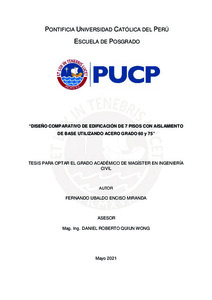| dc.contributor.advisor | Quiun Wong, Daniel Roberto | |
| dc.contributor.author | Enciso Miranda, Fernando Ubaldo | |
| dc.date.accessioned | 2021-10-15T00:39:38Z | |
| dc.date.available | 2021-10-15T00:39:38Z | |
| dc.date.created | 2021 | |
| dc.date.issued | 2021-10-14 | |
| dc.identifier.uri | http://hdl.handle.net/20.500.12404/20661 | |
| dc.description.abstract | El Perú está ubicado en el conocido cinturón de fuego, donde interactúan la
placa de nazca bajo la sudamericana, el mismo que se desarrolla con una velocidad
promedio de 7-8 cm/año (DeMets et al, 1980; Norabuena et al, 1999), por lo que
estamos expuestos a movimientos tectónicos importantes con periodos de
recurrencia cortos, terremotos que han causado muchas muertes e ingentes perdidas
económicas; Arequipa está ubicada en una zona sísmica.
Debido a esta amenaza sísmica es que la innovación tecnológica estructural
propone la protección sísmica de las estructuras a través de dispositivos pasivos
como aisladores y disipadores de energía visco elásticos, de fricción o metálicos.
Estos permiten que las estructuras tengan un mejor comportamiento estructural,
desacoplando la estructura del suelo con estos dispositivos reduciendo drásticamente
el movimiento sísmico en la superestructura, pudiendo ser imperceptible por los
usuarios, mejorando su funcionalidad y operatividad de la edificación postsismo; sin
embargo, se tiene un incremento en el costo comparado con un diseño tradicional.
Al no tener mucha demanda sísmica la superestructura, se puede utilizar aceros de
alta resistencia para reducir secciones de concreto y minimizar densidades de acero
pudiendo tener intersecciones de acero (nudos) con poca interferencia.
En la tesis se utiliza aisladores LRB (goma con núcleo de plomo) para una
edificacion de 7 pisos regular en planta y elevación, con una relación de esbeltez de
2, presentando dos estructuraciones dual y aporticada. Comparamos sus
características estructurales de las edificaciones para un diseño convencional y luego
de proponer el sistema de aislamiento con 2 tipos de dispositivos LRB para cada
estructuración se diseña la propuesta de edificacion aislada con estructuración dual
con acero de construcción grado 60 y la edificacion aporticada con acero grado 75.
Se realiza una comparación de metrados y presupuesto de partidas de estructuras
para las 2 estructuraciones con cantidades de acero y concreto en columnas y vigas.
Se concluye que es conveniente estructurar las edificaciones aisladas
aporticadas y utilizar acero grado 75 u 80 sin incrementar sustancialmente el costo
de una edificacion aislada. | es_ES |
| dc.description.abstract | Peru is located in the well-known belt of fire, where the Nazca plate under
the South American plate interacts, the same one that develops with an average speed
of 7-8 cm / year (DeMets et al, 1980; Norabuena et al, 1999), so we are exposed to
important tectonic movements with short repetition periods, earthquakes that have
caused many deaths and huge economic losses; Arequipa is located in a seismic zone.
Due to this seismic threat, the structural technological innovation proposes
the seismic protection of structures through passive devices such as insulators and
visco-elastic, friction or metallic energy dissipators. These devices allow the
structures to have a better structural behavior, decoupling the structure from the
ground with these devices, drastically reducing the seismic movement in the
superstructure, which can be imperceptible by users, improving its functionality and
operability of the post-earthquake building; however, there is an increase in cost
compared to a traditional design. As the superstructure does not have much seismic
demand, high-strength steels can be used to reduce concrete sections and minimize
steel densities, being able to have steel intersections (knots) with little interference.
In the thesis, LRB insulators (lead core rubber) are used for a building of 7
levels with regular plan and elevation, with a slenderness ratio of 2, presenting two
dual and porticoed structures. We compare the structural characteristics of the
buildings for a conventional design and after proposing the insulation system with 2
types of LRB devices for each structuring, the isolated building proposal is designed
with dual structuring with 60-degree construction steel and the building provided
with 75-degree steel. A comparison of metrics and budget of structure items is made
for the 2 structures with quantities of steel and concrete in columns and beams.
It is concluded that it is convenient to structure the porched isolated buildings
and use 75 or 80-degree steel without substantially increasing the cost of an isolated
building. | es_ES |
| dc.language.iso | spa | es_ES |
| dc.publisher | Pontificia Universidad Católica del Perú | es_ES |
| dc.rights | info:eu-repo/semantics/openAccess | es_ES |
| dc.rights.uri | http://creativecommons.org/licenses/by-nc-sa/2.5/pe/ | * |
| dc.subject | Análisis estructural (Ingeniería) | es_ES |
| dc.subject | Diseño de estructuras--Aisladores | es_ES |
| dc.subject | Construcciones antisísmicas--Evaluación | es_ES |
| dc.title | Diseño comparativo de edificación de 7 pisos con aislamiento de base utilizando acero grado 60 y 75 | es_ES |
| dc.type | info:eu-repo/semantics/masterThesis | es_ES |
| thesis.degree.name | Maestro en Ingeniería Civil | es_ES |
| thesis.degree.level | Maestría | es_ES |
| thesis.degree.grantor | Pontificia Universidad Católica del Perú. Escuela de Posgrado. | es_ES |
| thesis.degree.discipline | Ingeniería Civil | es_ES |
| renati.advisor.dni | 07800490 | |
| renati.advisor.orcid | https://orcid.org/0000-0001-8906-6783 | es_ES |
| renati.author.dni | 29282160 | |
| renati.discipline | 732267 | es_ES |
| renati.juror | Zegarra Ciquero, Luis Antonio | |
| renati.juror | Quiun Wong, Daniel Roberto | |
| renati.juror | Santos Cavalho, Dennis Jesús | |
| renati.level | https://purl.org/pe-repo/renati/level#maestro | es_ES |
| renati.type | https://purl.org/pe-repo/renati/type#tesis | es_ES |
| dc.publisher.country | PE | es_ES |
| dc.subject.ocde | https://purl.org/pe-repo/ocde/ford#2.01.01 | es_ES |






